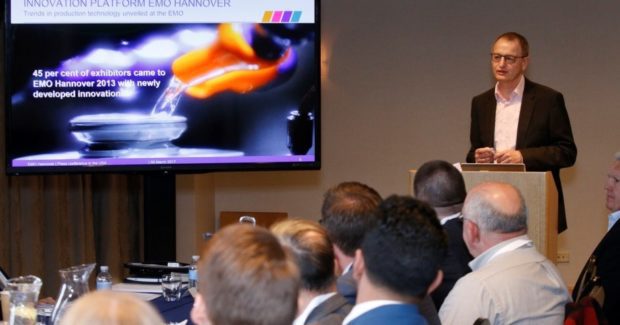Connecting Systems for Intelligent Production
After a four-year break, EMO Hannover 2017 promises all sorts of new equipment and systems for metalworking shops to compete in the Internet of Things.
Posted: March 15, 2017
This is an EMO year. Following a four-year break, one of the world’s premier trade fairs for the metalworking sector will once again be held in Hannover, Germany, from September 18-23, 2017. “Under the motto of “Connecting systems for intelligent production,” manufacturers of production technology from all over the world will be showing what solutions exist for generating maximized user benefits from the digitization and networking of production operations,” a point emphasized by Dr. Wilfried Schäfer, the executive director of EMO organizer VDW (German Machine Tool Builders’ Association; Frankfurt, Germany), who spoke at the recent EMO press conferences held in Chicago on March 9. “The aim, of course, is to also improve the competitiveness of the machine tool vendors that are exhibiting these new solutions,” he added.
As one of the world’s premier trade fairs, EMO Hannover scores highly in terms of sheer size, international exposure and the number of innovations being unveiled. In the middle of February 2017, almost 1,900 firms from 42 different countries had already signed up to exhibit at the show, using around 160,000 sq m of net exhibition area. The current registration status “is significantly above the comparable figure for the previous event,” noted Dr. Schäfer. “There are plenty of indications that this year’s event is heading for a record participation level.” This event is an absolute hot-spot for international experts in the metalworking sector, as reflected by the volume of visitors: In 2013, around 143,000 attendees from over 110 different countries toured the event. The proportion of visitors from abroad was 42 percent. No other event for production technology anywhere in the world can record such a high proportion of foreign visitors.
In Hannover, the exhibitors meet only trade visitors who are primarily characterized by high quality and decision-making powers. For example, 80 percent stated in the last visitor survey that they exert an influence on procurement decisions in their companies. The exhibitors’ expectations for after-fair business were correspondingly high. In fact, the fourth quarter of 2013 saw a turnaround: Following a fall in international order bookings extending over seven quarters, orders rose again for the first time with an increase of six percent. “We class this as an EMO effect,” remarked Dr. Schäfer.
This show is regarded as a shop window into innovation for production technology. In many cases, exhibitors schedule the launch of their new products to coincide with the dates of the show so that they can introduce them to an international trade public at the fair. “This is why many trends, such as flexible manufacturing concepts, high-speed machining and the use of linear drives, just to name a few, began their successful progress in the production environment at EMO,” said Dr. Schäfer. In 2013, 45 percent of the exhibitors stated they had come to the fair with newly developed products to showcase.
FROM CLASSIC PERFORMANCE TO NEW CAPABILITIES
The paramount topics of discussion in the international world of production technology are digitization and networking. However, the classic essential requirements for machine tools and manufacturing systems are still of huge importance: mechanical sturdiness, dependable components, reliable machinery control systems plus intelligent process design and control are still the foundations for quality, productivity and cost efficient manufacturing. A broad spectrum of different machine tools that address these requirements will be showcased at the EMO Hannover.
Some of these will be affordable standard machines, with simple machinery concepts and abundant modification options that can be supplemented at need by available accessories. They use maintenance-friendly standard components in sturdy construction, with easy operator control features that offer performative advantages that are frequently requested by users in price-sensitive markets. For example, it is possible to create entirely new scenarios for shops engaged in steel construction, in simple mechanical manufacturing or in multi-purpose machinery production by simply upgrading a triple-axis machine tool with a fourth axis that can be linked up at need. By contrast, standardized concepts for part and tool clamping can minimize the ancillary costs involved in purchasing a new machine.
Another major group are machines for tool and die construction that offer particular support when it comes to programming complex free surfaces. They can also cope with lengthy part run times, very largely without an operator. For repairing expensive tools, additional processes from additive manufacturing can be integrated. New requirements for specialized haptic surfaces are met by using laser or ultrasonic systems for surface structuring.
Another category is productive multi-purpose and specialized machines for ultra-high-quality requirements in large-series and mass production runs that integrate numerous automation solutions, from simple pallet change-overs to fully automated storage and handling systems. They ensure favorable unit costs through complete machining and technology integration, while providing maximized reproducibility and availability.
All of the performance features being described here are linked up to new options in the digital world in order to optimize the manufacturing processes in the users’ plants and to increase availability or output. It is here, for instance, that big data come into play, one of the topics that’s being intensively discussed. For special applications in the production environment, numerous measured and sensor data acquired about the machine tool’s status must be liberated from their “data graves.” Detailed analyses extending over large quantities of data contribute toward the early detection of imminent failures, e.g. of main spindles or feed axes, and predict the moment when maintenance is going to be needed more precisely than had previously been possible.
The new approaches being used in predictive maintenance, based on teachable algorithms, extend far beyond classical condition monitoring of individual machines. The status of all machines in a manufacturing system are acquired, centrally monitored on a continuous basis, and the requisite action initiated in response to real status data. This opens up entirely new options for performing maintenance or service jobs, where augmented reality supersedes the traditional maintenance manual: A service technician finds out what to do using a smartphone or a tablet. Here, a software system detects the section of the machine in which the technician is currently located. Online communication with the machine’s control system makes it easier to find a fault. Superimposed step-by-step instructions for repair replace elaborate and costly product training courses on the customer’s premises. Even personnel who have not been specially trained are able to take initial measures for remedying a malfunction.
INTELLIGENT PRODUCTION IN A NETWORK OF POSSIBILITIES
EMO organizers are confident that this year’s event will generate important incentives for implementing the much-discussed concept of Industry 4.0 or the Internet of Things (IoT). “In the machine tool, we have long since implemented digitization,” stated Dr. Schäfer. “For example, digital images for simulations have lbeen possible for quite a long time now.” Under the keyword of Industry 4.0, the task now is to network the entire production operation – in fact, the complete added-value chain.
In a consistently networked manufacturing line, flexible production becomes possible with optimized process sequences so that even rush orders in small batch sizes can be handled. Complete networking of the entire production line, using real-time communication and control, will create maximized added value for shops when they implement horizontal communication all the way from receipt of the order through to dispatch. Furthermore, within the added-value chain it’s important to network not only the component suppliers, but also the logistical partners and the customers involved in jobs to achieve maximized productivity, flexibility and efficiency.
A SHOWCASE OF BEST PRACTICE FOR MID-SIZED SHOPS
Small and mid-size shops still find it particularly difficult to implement a completely automated and networked smart factory because it involves very substantial investment. For this reason, it’s more realistic to move forward to Industry 4.0 in relatively small steps. Numerous detailed innovations create an added value for machine tool users and upgrade the competitiveness of their machinery manufacturer. Many of these ingenious solutions will be showcased at EMO Hannover, including:
- New methods for intelligent tool management with direct transfer of tool data to the machine to reduce the workload involved in production planning.
- Feedback of offline measured data for a self-regulating optimal process control system for tool grinding.
- Sensor and software systems for simpler, control-system-independent machine monitoring from the component level to the entire factory.
- Approaches for mastering data transmission and data security.
- Assistance systems for increasing productivity through cooperative networking of machines and ERP systems.
- Business platforms for holistic organizing of production operations on the basis of real-time data.
- Communication environments for transparent, independent, open and simultaneously secure data interchange along the entire added-value chain.
- Apps for individually configurable control systems that are designed to ensure improved operator-friendliness and expanded connectivity, and much more.
“The inventiveness being displayed in the production environment is enormous,” adds Dr. Schäfer. EMO Hannover 2017 promises to stimulate ideas for the practical use of new systems meeting every metalworking need, under widely varying preconditions.










